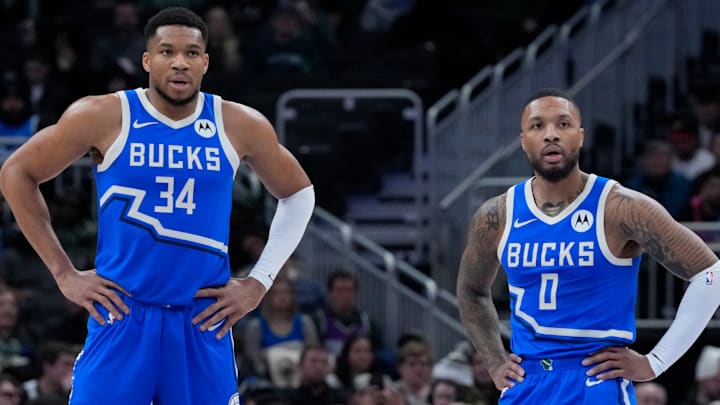If Giannis Antetokounmpo ever gets his wish and winds up being traded to the New York Knicks, Leon Rose and the rest of the front office should promptly send Damian Lillard a gift basket. The prospect of a Giannis-to-the-Knicks timeline would not exist if he didn’t move on from the Portland Trail Blazers in 2023, and cost the Milwaukee Bucks control over so much of their future.
Of course, in this scenario, New York should also thank Bucks general manager Jon Horst, He oversaw the acquisition of Lillard—a totally justifiable move at the time, to be sure, but one that has put the franchise in an awkward situation now that its two-time MVP is a flight risk.
As ESPN’s Shams Charania recently reported, Giannis developed wandering eyes over the offseason for the Knicks, and the Knicks alone. Nothing came of preliminary talks between Milwaukee and New York, but as The Athletic’s Fred Katz and James L. Edwards III noted, this dalliance isn’t necessarily over. Talks could resume during the middle of the season, once Mikal Bridges becomes trade-eligible on Feb. 1, or the two sides could regroup over the summer.
Regardless of when the Bucks and Giannis inevitably part ways, the Knicks should be working from a position of weakness. The 30-year-old pushing to join them doesn’t change the fact that they don’t have a traditional cache of star-trade assets.
New York cannot promise a single first-rounder until the summer. Even then, it will only have two picks to dangle (2026 and 2033). And yet, Milwaukee may not be as obsessed with receiving the traditional superstar-trade return. Which brings us back to Damian Lillard.
The Bucks may not want to totally rebuild post-Giannis trade
As part of the deal that brought them Lillard, the Bucks gave up control of their 2028, 2029, and 2030 first-round picks. (The 2028 and 2030 obligations are swaps.) With their 2026 (swap) and 2027 (outright) selections already headed elsewhere from the 2020 Jrue Holiday trade, they do not control their own first again until 2031.
Milwaukee has no incentive to tank as a result if and when it moves Giannis. That could compel the front office to prioritize—or at least warm up to—offers built predominantly around immediate talent.
These parameters are right up the Knicks’ alley. Depending on when a deal would go down, they can offer some combination of Bridges, OG Anunoby, Karl-Anthony Towns, Josh Hart, Deuce McBride, and Mitchell Robinson—all players capable of contributing to win-now windows.
This doesn’t automatically give New York one of the best possible packages. Other teams like the Atlanta Hawks and Houston Rockets can straddle both lines, offering players who contribute now, and waaaaaaay more draft equity than the Knicks can muster. Most of the players in alternative packages would also be younger. None of New York’s outgoing names would be under the age of 25, unless you’re prepared to count Tyler Kolek.
Still, the Knicks will need to get lucky to land Giannis at all. In some ways, they are already fortunate. The blueprint for a deal doesn’t exist without his (apparent) self-proclaimed interest.
It also doesn’t exist without the Bucks’ draft obligations forcing them to consider a post-Giannis timeline that isn’t defined by a full-tilt rebuild—a wrinkle for which New York should be grateful, and on which it couldn’t capitalize without Damian Lillard.
